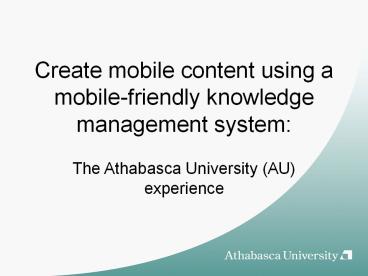Create mobile content using a mobile-friendly knowledge management system: - PowerPoint PPT Presentation
Title:
Create mobile content using a mobile-friendly knowledge management system:
Description:
... (http://www.moodle.org) Sakai ... a service oriented architecture approach will be implemented into this adapter to provide more efficient and accurate ... – PowerPoint PPT presentation
Number of Views:135
Avg rating:3.0/5.0
Title: Create mobile content using a mobile-friendly knowledge management system:
1
Create mobile content using a mobile-friendly
knowledge management system
The Athabasca University (AU) experience
2
Presentation
- Introduction
- Mobile-friendly Knowledge Management System
(MKMS) - Mobile Device Automatic Detector
- Conclusion and Future work
3
4
5
6
7
A Mobile-friendly Knowledge Management System
Hongxing Geng
8
Outline
- Introduction
- Related work
- Mobile-friendly Knowledge Management System
(MKMS) - Conclusion and Future work
9
Introduction
- What is a KMS?
- What is a MKMS?
- Why do we need a MKMS?
- Existing KMSs have disadvantages
- Knowledge sharing
- Knowledge accessible anytime anywhere
10
Related work
- Moodle (http//www.moodle.org)
- Sakai (http//www.sakaiproject.org)
- MOMO (http//mobilemoodle.org)
11
MKMS Design
- Design principles
- Web-based application
- Simple
- Multiple languages support
- Extensible
- Maintainable
12
MKMS System Architecture
- Architecture
- Knowledge Node Organization
13
MKMS Implementation
- Prototype
- PHP and Zend Framework
- MySQL database
- Multiple Language support (.ini)
14
MKMS Features
- Accessible through mobile devices
- Two views admin view and learners view
- Management create, delete, organize, and
publish/unpublish, etc - Using metadata to describe knowledge entries
15
Conclusion and Future work
- Conclusion
- Manage and view content through mobile devices
- Facilitate knowledge sharing
- Describe entries using metadata
- Future work
- Authentication and Authorization
- Quiz (multi-choice questions)
- Searching capacity
- OAI-compatible
16
Mobile Device Automatic Detector
A component in Personalized and Adaptive
M-learning Framework and Mobile Knowledge
Management System Guangbing Yang
17
Problem statement
- Capabilities of a mobile device decide what kind
of the content it can display correctly and what
context it can process properly - MKMS or other Mobile based LMS, like
Personalized Adaptive m-learning System needs to
know device capabilities before preparing and
transporting the suitable learning contents to
mobile clients
18
Our approach
Our approach
- design and develop a software API to detect the
device information in details. Such information
includes the device type, device type name (e.g.
HTC, Samsung, iPhone, etc.), device OS, screen
resolution, image type supported, etc. - establish a device profile repository to store
mobile device specifications - generate device profile ontology and output RDFS
or OWL - provide mobile profile retrieving services that
can be consumed easily by other applications
19
System architecture
System architecture
- Service Oriented Architecture
- XML format data exchanging between server and
mobile client - XSL selection dependent on mobile device profile
- Multi-language support
- Multi-platform support
20
System architecture
architecture
21
Experiment
4 Devices
IPHONE
Experimental
22
Experiment
HTC Smartphone profile (sample)
Experimental
ltrdfRDFgt ltrdfDescription rdfID"Profile"gt ltprf
componentgt ltrdfDescription rdfID"HardwarePlatfo
rm"gt ltrdftype rdfresource"http//www.openmobile
alliance.org/tech/profiles/UAPROF/ccppschema-20021
212HardwarePlatform"/gt ltprfModelgtPolarislt/prfMo
delgt ltprfVendorgtHigh Tech Computer
Corporationlt/prfVendorgt ltprfBitsPerPixelgt16lt/prf
BitsPerPixelgt ltprfColorCapablegtYeslt/prfColorCap
ablegt ltprfScreenSizegt240x320lt/prfScreenSizegt ltpr
fImageCapablegtYeslt/prfImageCapablegt ltprfPixelAs
pectRatiogt1x1lt/prfPixelAspectRatiogt ltprfScreenSi
zeChargt16x36lt/prfScreenSizeChargt ltprfStandardFon
tProportionalgtYeslt/prfStandardFontProportionalgt lt
prfSoundOutputCapablegtYeslt/prfSoundOutputCapable
gt ltprfTextInputCapablegtYeslt/prfTextInputCapablegt
ltprfVoiceInputCapablegtYeslt/prfVoiceInputCapable
gt ltprfInputCharSetgt ltrdfBaggt ltrdfligtUS-ASCIIlt/r
dfligt ltrdfligtUTF-8lt/rdfligt ltrdfligtUTF-16lt/rdf
ligt ltrdfligtISO-10646-UCS-2lt/rdfligt lt/rdfBaggt lt/
prfInputCharSetgt
23
Conclusion and further work
Conclusion and further work
- Described an approach of design and
implementation of a mobile device detection
adapter to lookup and generate the device profile - Based on the detailed information in the device
profile, personalized adaptive m-Learning system
or mobile knowledge management system can deliver
or transport adaptive context and content to
learners. - In next step, a service oriented architecture
approach will be implemented into this adapter to
provide more efficient and accurate device
profile searching and retrieving services.
video
24
Conclusion































